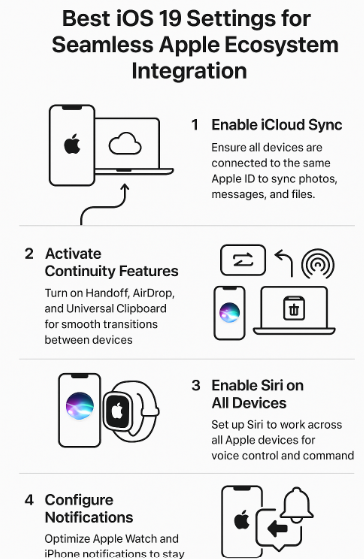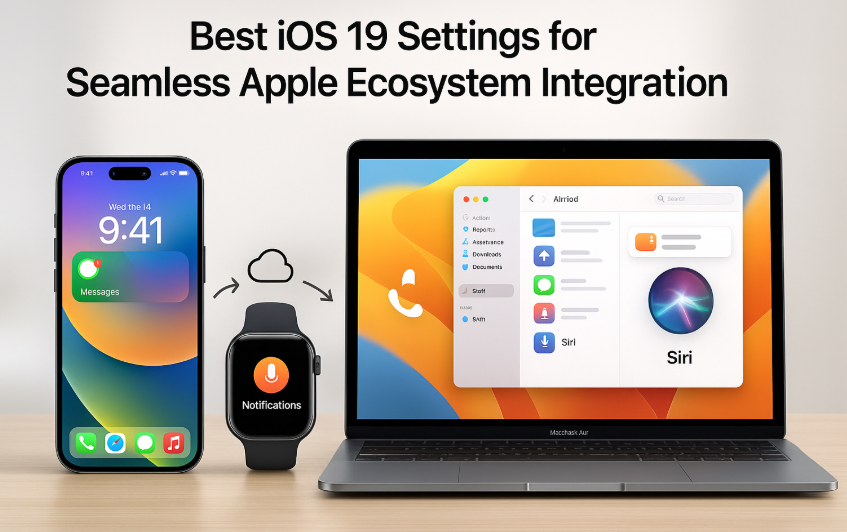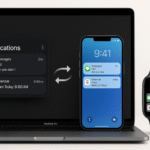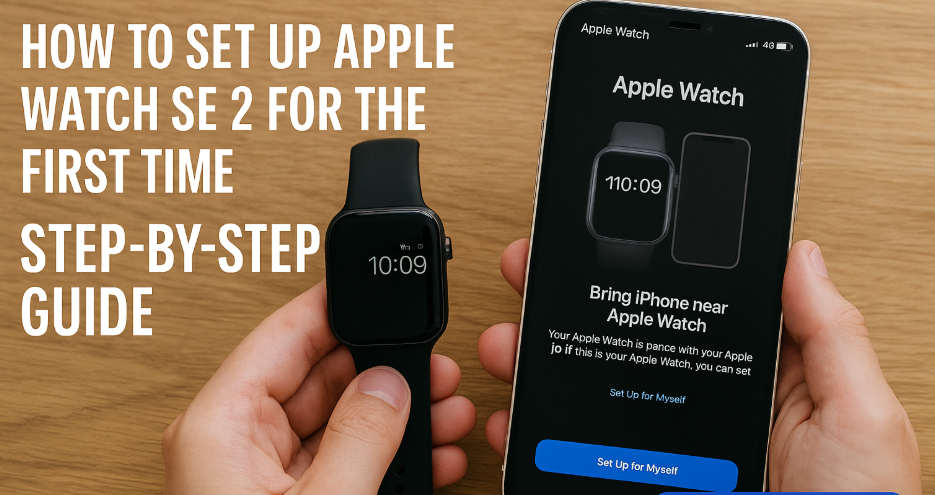The Apple ecosystem has always been lauded for its seamless integration across multiple devices, allowing users to easily sync their iPhone, iPad, Mac, and Apple Watch. With the release of iOS 19, Apple continues to enhance its ecosystem’s connectivity, making it more intuitive and productive than ever. To truly get the most out of your devices, it’s essential to configure the right settings. Here’s how you can optimize iOS 19 for maximum Apple ecosystem compatibility.
For insights into the latest features on your Apple Watch SE 2nd Gen, check out our Comprehensive Guide.
Step 1: Enable iCloud for Seamless Synchronization
The backbone of Apple’s ecosystem is iCloud, which ensures that your data, apps, and files are available across all devices. To maximize Apple ecosystem compatibility, ensuring iCloud is activated and set up on all your devices is crucial.
How to Set Up iCloud:
- On iPhone:
- Go to Settings > [Your Name] > iCloud.
- Turn on syncing for Photos, Contacts, Calendars, and other apps you want to be shared across devices.
- On Apple Watch:
- Your Apple Watch will automatically sync with iCloud when paired with your iPhone, ensuring your photos, health data, and apps are accessible across devices.
- On Mac:
- Open System Preferences > Apple ID > iCloud.
- Enable syncing for iCloud Drive, Photos, and other important settings to ensure all your Mac data syncs seamlessly.
iCloud sync ensures you have access to your contacts, notes, calendars, and photos no matter which device you’re using. It also helps in keeping apps like Find My, Safari, and iMessages synchronized across all Apple devices.
Step 2: Enable Continuity Features
Apple’s Continuity features are the key to smooth transitions between your devices. From Handoff to AirDrop to Universal Clipboard, enabling these features allows you to start a task on one device and continue it on another. Whether you’re moving from an iPhone to a Mac or answering a phone call on your Apple Watch, Continuity makes it easy.
How to Set Up Continuity:
- Handoff:
- On your iPhone: Go to Settings > General > AirPlay & Handoff, and toggle Handoff to ON.
- On Mac: Go to System Preferences > General and check Allow Handoff between this Mac and your iCloud devices.
- AirDrop:
- On iPhone/Apple Watch: Swipe to open Control Center, and ensure AirDrop is set to either Contacts Only or Everyone for easier sharing.
- On Mac: In Finder, go to AirDrop and set it to Everyone or Contacts Only.
- Universal Clipboard:
- Universal Clipboard allows you to copy content on one Apple device and paste it onto another. Make sure your devices are signed in to the same Apple ID, and Bluetooth is enabled for this feature to work.
Enabling these features ensures that your Apple devices work together seamlessly, saving time and reducing frustration.
Step 3: Optimize Notifications for iPhone and Apple Watch
Notifications are an essential part of staying connected, but if they’re not managed well, they can lead to distractions. iOS 19 introduces new settings to optimize notifications between your iPhone and Apple Watch, helping you stay organized and focused without missing important alerts.
How to Optimize Notifications:
- On iPhone:
- Go to Settings > Notifications to configure how apps notify you.
- Customize your notifications by setting Do Not Disturb schedules and choosing which apps can send alerts.
- On Apple Watch:
- Open Watch app on your iPhone, then go to Notifications.
- Choose whether you want to mirror your iPhone’s notification settings or customize the notifications on your Apple Watch.
With these settings, you’ll only get the notifications that matter most, ensuring that you stay productive without being overwhelmed.

Step 4: Customize Siri for Cross-Device Control
Siri is more than just a voice assistant; it’s the key to controlling your entire Apple ecosystem. Whether you’re managing your smart home devices or sending messages across your iPhone and Mac, optimizing Siri is essential for seamless cross-device control.
How to Optimize Siri:
- On iPhone:
- Go to Settings > Siri & Search, and ensure Listen for “Hey Siri” and Allow Siri When Locked are enabled.
- On Apple Watch:
- Open Settings > Siri to enable hands-free use by saying “Hey Siri” or raising your wrist.
- On Mac:
- Go to System Preferences > Siri, and toggle Enable Siri to ON. You can also set up keyboard shortcuts or use voice commands.
By configuring Siri across all your devices, you can control your entire Apple ecosystem with just your voice.
Step 5: Set Up Family Sharing for Multi-Device Management
If you’re sharing your devices with family members, setting up Family Sharing allows for better control over purchases, subscriptions, and data sharing across devices. This is especially useful for managing multiple Apple devices within a family.
How to Set Up Family Sharing:
- On iPhone:
- Go to Settings > [Your Name] > Family Sharing, and follow the prompts to set up Family Sharing.
- On Mac:
- Open System Preferences > Apple ID > Family Sharing, and follow the steps to add family members.
- On Apple Watch:
- Ensure your Apple Watch is paired with your iPhone, and your iCloud settings are synced for Family Sharing.
Family Sharing makes it easier to share app purchases, subscriptions like Apple Music or Apple TV+, and location data with your family members.
Step 6: Troubleshooting Common Issues
Even with iOS 19 and the Apple ecosystem, issues can sometimes arise. Here are some common problems and solutions to get you back on track:
Problem 1: Devices Aren’t Syncing Properly
- Solution: Ensure all devices are signed in to iCloud with the same Apple ID and that Bluetooth is enabled.
Problem 2: Handoff Isn’t Working
- Solution: Make sure Handoff is enabled on all devices, and ensure that the devices are on the same Wi-Fi network.
Problem 3: Siri Doesn’t Recognize Commands Across Devices
- Solution: Check that Siri is enabled on all devices and ensure the devices are signed in with the same Apple ID.
Conclusion
With iOS 19, Apple continues to build on its seamless ecosystem, allowing you to optimize how your devices interact. By configuring iCloud, enabling Continuity features, optimizing Siri, and managing notifications effectively, you can ensure a smooth and productive experience across all Apple devices.
For more tips on Apple ecosystem optimization, check out these articles:







